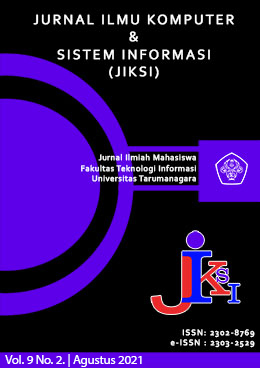PERANCANGAN SISTEM PENUNJANG KEPUTUSAN PENCARIAN JARAK TERPENDEK MENUJU RUMAH SAKIT DAN PUSKESMAS DENGAN METODE DIJKSTRA
Main Article Content
Abstract
Advances in technology and information offer various conveniences and alternatives in every activity and community activity. There are various types of activities and community activities that do not escape the role of technology and information. Of course, this makes it easier for the community to make decisions in every activity and activity. In fact, in determining the fastest route, people are faced with a choice of available routes and are required to make the right decision regarding the alternative shortest route. One of them is in determining the route/path to hospitals and health centers. To take the shortest route/path, you can use public transportation, such as buses, which are often the people's choice compared to other modes of transportation. The existence of hospitals and health centers is very important because they can help treat people who are sick and provide 24-hour Emergency Unit (ER) services. In particular, immigrants who still don't know where the hospitals and health centers are and have to take which route is closer to where they are. Dijkstra's method is very effectively used to map alternative paths, if the main route experiences obstacles. In addition, it can be used to solve the problem of the shortest route/path and maximum flow, the elements (weights) of the route are the distance traveled and the cost. Dijkstra's method does not solve the problem of negative lines and only looks for the minimum value from one node to another that is related to each other. In its implementation, the Dijkstra method can use dynamic or changing data.
Article Details
This work is licensed under a Jurnal Komunikasi Creative Commons Attribution-ShareAlike 4.0 International License.
References
D, Pugas Okta; dkk. Pencarian Rute Terpendek Menggunakan Algoritma Dijkstra dan Astar (A*) pada SIG Berbasis Web untuk Pemetaan Pariwisata Kota Sawahlunto, Semarang: Universitas Diponegoro Semarang, 2011..
E., Turban. Decision SupportSystem and Intelligent System, Yogyakarta: Andi Publisher, 2007.
Erawati, Dewi Luh Joni. Pencarian Rute Terpendek Tempat Wisata Di Bali Dengan Menggunakan Algoritma Dijkstra, Yogyakarta: Seminar Nasional Aplikasi Teknologi Informasi (SNATI), 2010.
Imron, Fauzi. Penggunaan Algoritma Dijkstra Dalam Pencarian Rute Tercepat dan Rute Terpendek, Jakarta: UIN Syarif Hidayatullah Jakarta, 2011.
Priatmoko. Algoritma Dijkstra Untuk Pencarian Jalur Terdekat dan Rekomendasi Objek Pariwisata di Pulau Bali, Semarang: Universitas Dian Nuswantoro Semarang, 2012.



